PULSAR KRYPTON FXG50 Manual
Specifications
| Model | FXG50 | |
| SKU | 76655 | |
| Microbolometer | ||
| Type | Uncooled | |
| Resolution, Pixels | 640×480 | |
| Pixel Pitch, µm | 12 | |
| Frame Rate, Hz | 50 | |
| Optical Characteristics | ||
| Magnification of Attachment, x | 1 | |
| Recommended Daylight Optics Magnification, x | 1.5-6 | |
| Lens | F50/1.2 | |
| Field-of-view (Horizontal), deg/m per 100 m | 8.7/15.4 | |
| Detection Range (animal height 1.7 m), m/y | 2300/2515 | |
| Minimum Focusing Distance, m/y | 5/5.47 | |
| Display | ||
| Type | AMOLED | |
| Resolution, Pixels | 1746×1000 | |
| Operational Characteristics | ||
| Power Supply, V | 3-4.2 | |
| Battery type/ Capacity/ Rated Output Voltage | Li-Ion Battery Pack IPS 7 / 6400 mAh / DC 3.7 V | |
| External Power Supply | 5 V (USB) | |
| Max. Battery Pack Life (at t = 22 °C), Hour* | 8 | |
| Degree of protection IP code (IEC60529) | IPX7 | |
| Maximum Recoil Power When Used with a Rifled Weapon, Joules | 6000 | |
| Maximum Shock-Resistance When Used with a Slug Gun, Caliber | 12 | |
| Operating temperature, °C / °F | -25 – +50 / -13 – +122 | |
| Overall Dimensions, mm/inch | 143х93х76 / 5.63×3.66×2.99 | |
| Weight (without Battery), kg/oz | 0.52 / 18.34 | |
| Video Recorder | ||
| Photo/Video Resolution, Pixels | 960×720 | |
| Video/Photo Format | .mp4/.jpg | |
| Built-in Memory | 16 GB | |
| Wi-Fi Channel** | ||
| Frequency | 2.4 GHz | |
| Standard | 802.11 b/g | |
| Bluetooth | ||
| Wireless Protocol | BLE 4.2 | |
* Actual operating time will depend to what extent the Wi-Fi and built-in video recorder is used.
** The reception range may vary depending on various factors: obstacles, other Wi-Fi networks.
About the device
Description
Thermal Imaging Front Attachment Krypton FXG50 is a multipurpose device that allows you to quickly and easily transform a daylight riflescope into a thermal imaging one.
The attachment is mounted on the lens of an riflescope with the help of adapters designed for various lens diameters. The attachment does not require any additional adjustment.
The attachment is intended for various applications, including hunting, sport shooting, night photography & video recording, and surveillance.
Package contents
- Thermal Imaging Attachment
- Carrying Case
- Wireless Remote Control
- IPS7 Battery Pack
- Battery Pack Charger
- Power Adapter
- USB Cable
- Quick Start Guide
- Lens-Cleaning Cloth
- Warranty Card
Features
- High resolution thermal imaging microbolometer
- Microbolometer pixel size of 12 microns
- High-resolution AMOLED display
- Easily converts daylight optical riflescopes into thermal imaging riflescopes
- Preserves the benefits of daylight optics in night-time conditions
- Three calibration modes (manual, semi-automatic and automatic)
- Four observation modes: Forest, Rocks, Identification, User
- Compatible with a wide range of daylight optical magnifications
- Detection distance up to 2300 m
- Wireless remote control
- High caliber recoil resistance 12 gauge, 9.3×64, .375 H&H
- Instant start
- Display off function
- Built-in video recording
- Remote Firmware update
- Fully watertight (IPX7 protection class)
- Wide operating temperature range (-25 °С – +50°С)
Video/audio recording
- Built-in video recorder
- Integration with iOS and Android devices
- Wi-Fi Smartphone remote control and surveillance
- Storing photos and videos in Cloud when using the Stream Vision 2 App
Battery Pack
- Quick-change IPS7 Li-ion battery pack
- USB charging option
Components and controls

- Lens cover
- Eyepiece cover
- Battery compartment cover
- Battery locking lever
- Battery pack
- RIGHT/REC button
- MENU button
- LEFT/MODE button
- ON/OFF/CALIBRATION button
- Lens focus knob
- MicroUSB port
- Weaver rail
- Objective lens end of daylight riflescope
- Insert
- Adapter
- Screws
- Tightening screw
- Screw
- Adapter lever
- Mount
Power supply
External power supply

External power is supplied from an external source, such as a 5V Power Bank.
- Attach the external power source to the USB connector (11) on the device.
- The device will switch to operation from the external power supply, while the IPS7 battery will be gradually recharged.
- A battery icon
 will appear on the display showing charge level as a percentage.
will appear on the display showing charge level as a percentage. - If the device is operated from an external power source and the IPS7 battery is not connected, an icon
 is displayed.
is displayed. - Once the external power source is disconnected, the device will begin functioning on battery power.
Attention! Charging Power Bank IPS7 batteries at air temperatures below 0 °C can result in reduced battery life. When using external power, connect Power Bank to the switched-on device, which have worked for several minutes.
Precautions
- Always use the IPS charger supplied with the device (or purchased separately) to charge IPS batteries. Using an unsuitable charger can cause irreparable damage to the battery and fire.
- Do not charge the battery immediately after bringing it from cold to warm. Wait at least 30 minutes for the battery to warm up.
- Do not leave the battery unattended while charging.
- Do not use the charger if it has been modified or damaged.
- Do not leave the battery in a charger connected to the network after charging is complete.
- Do not expose the battery to high temperatures and naked flame.
- Do not use the battery as a power source for devices that do not support IPS7 batteries.
- Do not disassemble or deform the battery.
- Do not drop or strike the battery.
- Do not submerge the battery.
- Keep the battery out of the reach of children.
Attention! Please do not use the IPS 14 Battery Pack with the Krypton FXG50 due to the battery´s heavy weight.
Recommendations for battery use
- The battery should be partially charged for long-term storage – 50 to 80 %.
- The battery should be charged at an ambient temperature of 0°C…+35°C (+32°F…+95°F). Otherwise, lifespan of the battery will decrease significantly.
- When using the battery at sub-zero temperatures, the battery capacity decreases, this is normal and not a defect.
- Do not use the battery at temperatures outside the range of -25 °С…+50 °С (-13°F…+122°F) – this may reduce battery’s life.
- The battery has a short-circuit protection. However, any situation that may cause short-circuiting should be avoided.
Battery charging
The device is supplied with a rechargeable IPS7 Lithium-ion Battery Pack which allows the attachment to be used for up to 8 hours. Charge the battery before first use.
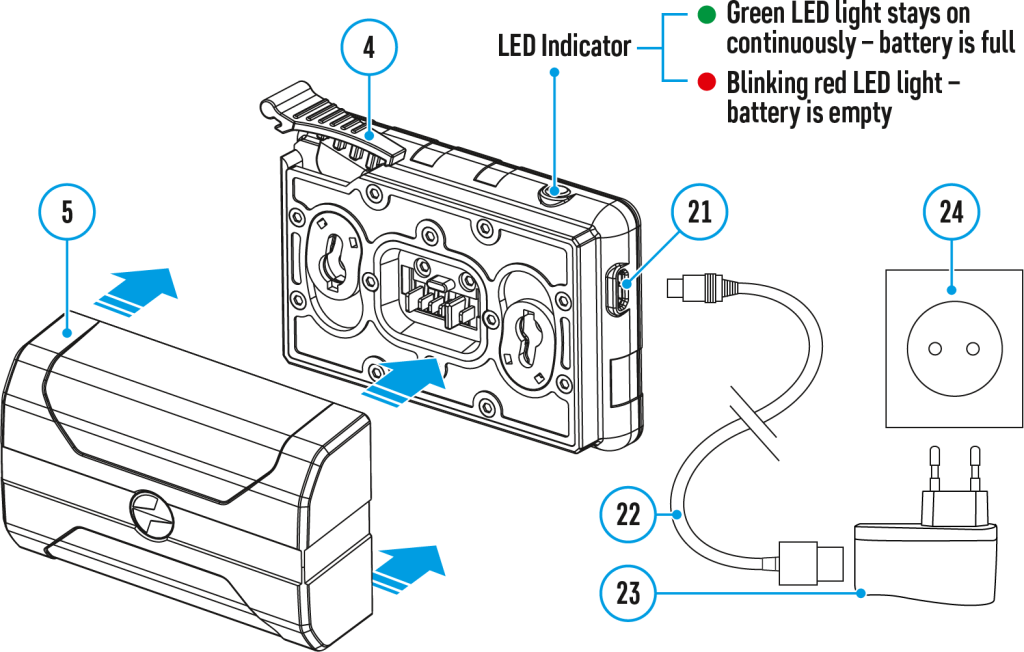
Charging
Step 1. Install the battery into the charger
- Raise the lever (4) of the charger.
- Install the Battery Pack (5) into the charger.
- Click the lever (4).
Step 2. Сheck the current battery level
- Upon installation, a green LED indicator on the charger will start to glow and begin flashing:
– once if the battery charge ranges from 0% to 50%.
– twice if the battery charge ranges from 51% to 75%.
– three times if the battery charge ranges from 76% to 100%.
- When the indicator is continuously green, the battery is fully charged. Disconnect the charger from the mains and disconnect the battery from the charger.
- If the battery charger indicator is constantly red when the battery is inserted, the charge level is probably below the permissible level (the battery has been in a discharged state for a long period of time). Leave the battery in the charger for a long period of time (up to several hours), then remove and reinsert.
- If the indicator begins to flash green, the battery is good.
- If it continues to show red, the battery is defective. Do not use this battery!
The LED indicator will display the battery charge status:
| LED Indicator | Battery Charge Status |
| Battery is empty | |
| Battery is full |
Step 3. Сonnect the charger to the mains supply
- Attach the microUSB plug of the USB cable (22) to the microUSB connector (21) on the charger.
- Connect the USB plug on the cable (22) to the power adapter (23).
- Plug the power adapter (23) into a 100-240V (24) socket.
- When the indicator is continuously green, the battery is fully charged. Disconnect the charger from the mains.
Battery installation

- Lower the lever (4).
- Remove the protective cover of the battery compartment (3).
- Insert the battery (5) into the slot designed for it on the attachment body so that the element (D) is pointing downwards.
- Lock the battery in place by raising the lever (4).
Getting started
Button operation
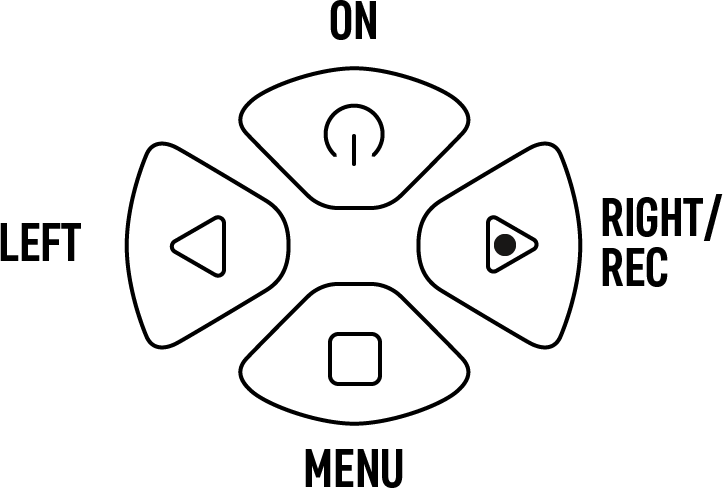
| Operation | Button |
| Power device on | |
| Power device off | |
| Turn display off | |
| Turn display on | |
| Calibrate the microbolometer | |
| Switch observation modes | |
| Turn on/off the Black Hot palette | |
| Video recorder | Button |
| Start/pause/resume video recording | |
| Stop video recording | |
| Switch to video / photo | |
| Capture Photo | |
| Main Menu | Button |
| Enter main menu | |
| Navigation down/counter-clockwise | |
| Navigation up/clockwise | |
| Confirm selection | |
| Exit submenu without confirming selection | |
| Exit menu (switch to viewing mode) | |
| Quick Menu | Button |
| Enter quick menu | |
| Switch between quick menu options | |
| Increase value | |
| Decrease value | |
| Exit quick menu |
Powering on and image settings
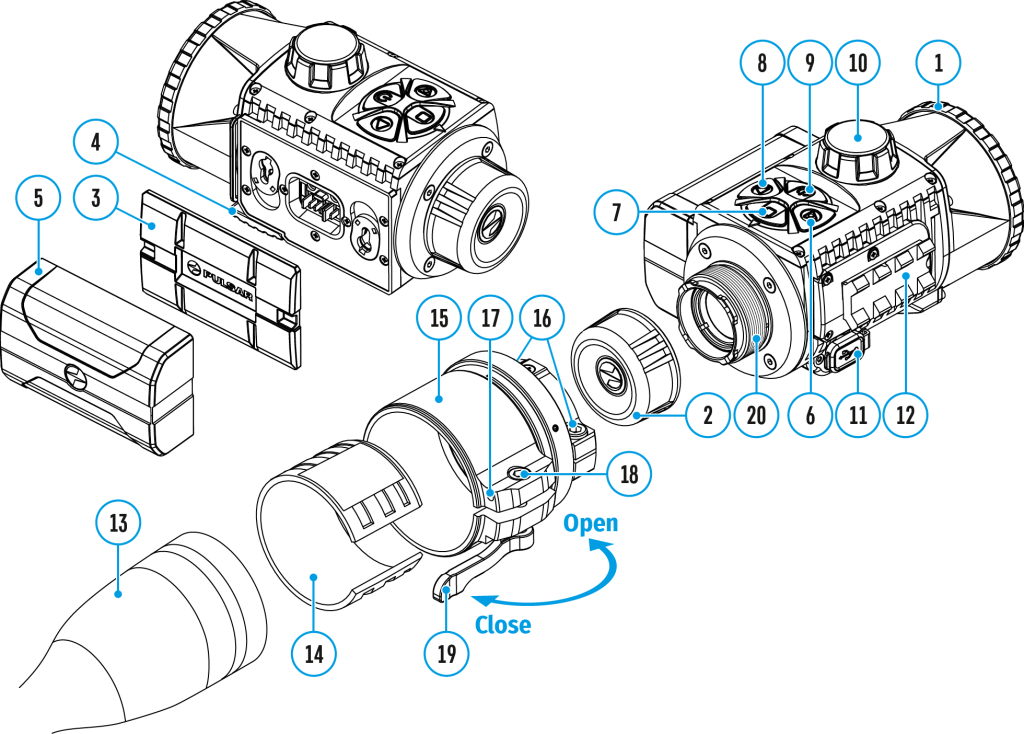
- Remove the lens cover (1) by turning it counterclockwise.
- Turn on the attachment by pressing the ON/OFF (9) button.
- If necessary, adjust the reticle sharpness according to the instructions for your riflescope.
- Rotate the lens focus knob (10) to focus on the visual target.
- Enter the main menu with a long press of the MENU (7) button and select the desired calibration mode: manual (M), semi-automatic (SA) or automatic (A).
- Calibrate the image by briefly pressing the ON/OFF (9) button. Close the lens cover when calibrating manually.
- Select the desired observation mode (Forest, Rocks, Identification or User) by briefly pressing the MODE (8) button or in the main menu. User mode allows you to configure and save custom brightness and contrast settings, as well as one of three modes as a base.
- Select one of the two color palettes by a long press of the MODE (8) button.
- Activate the quick menu by briefly pressing the MENU (7) button to adjust the brightness and contrast of the display.
- Upon completion of use turn the device off by a long press of the ON/OFF (9) button.
Attention! The lens of the device must not be pointed at any sources of intense energy, such as laser-emitting devices or the sun. This may damage the electronic components in the device. Damage caused by failure to comply with the operating guidelines is not covered under warranty.
Microbolometer calibration
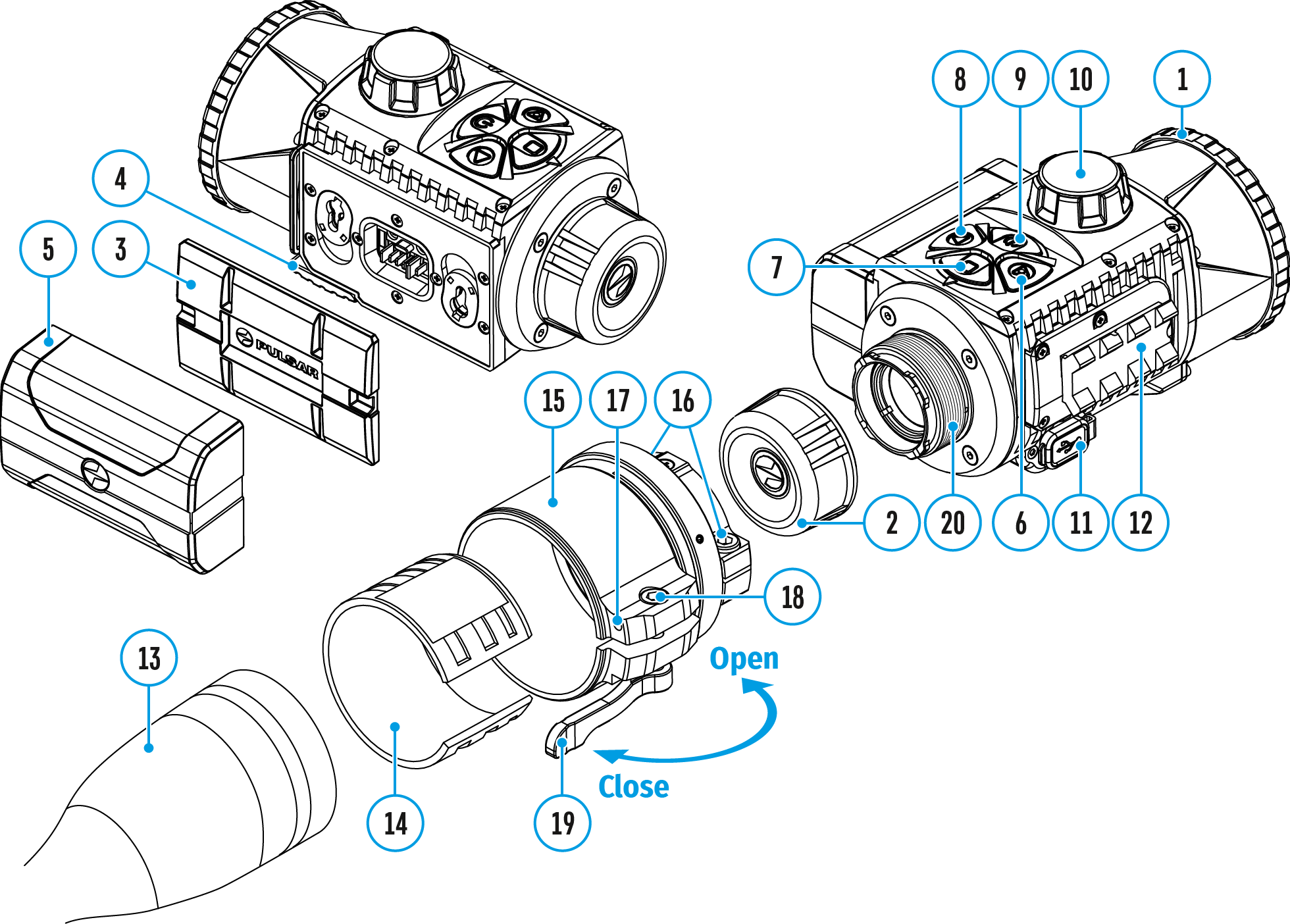
Calibration enables the device to equalize the microbolometer background temperature and eliminate the image flaws (such as vertical bars, phantom images, etc.).
During calibration, the image on the display briefly freezes for up to 1 second.
There are three calibration modes: Manual (M), Semi-Automatic (SA) and Automatic (A).
Select the required mode in the Calibration Mode ![]() menu item.
menu item.
M mode (Manual).
- Close the lens cover.
- Press the ON/OFF (9) button briefly.
- Open the lens cover after the calibration is completed.
SA mode (Semi-Automatic).
- Press the ON/OFF (9) button briefly to activate calibration.
- There is no need to close the lens cover because an internal shutter covers the microbolometer automatically.
A mode (Automatic).
- The device is calibrated autonomously according to firmware algorithms.
- There is no need to close the lens cover because an internal shutter covers the microbolometer automatically.
- In this mode, the user can still choose to calibrate the device using the ON/OFF (9) button if required (as in the SA mode).
- In Automatic calibration mode a countdown timer will appear instead of the calibration mode icon 3 seconds before automatic calibration begins.
Installing Pulsar 5X30 B monocular on to the attachment
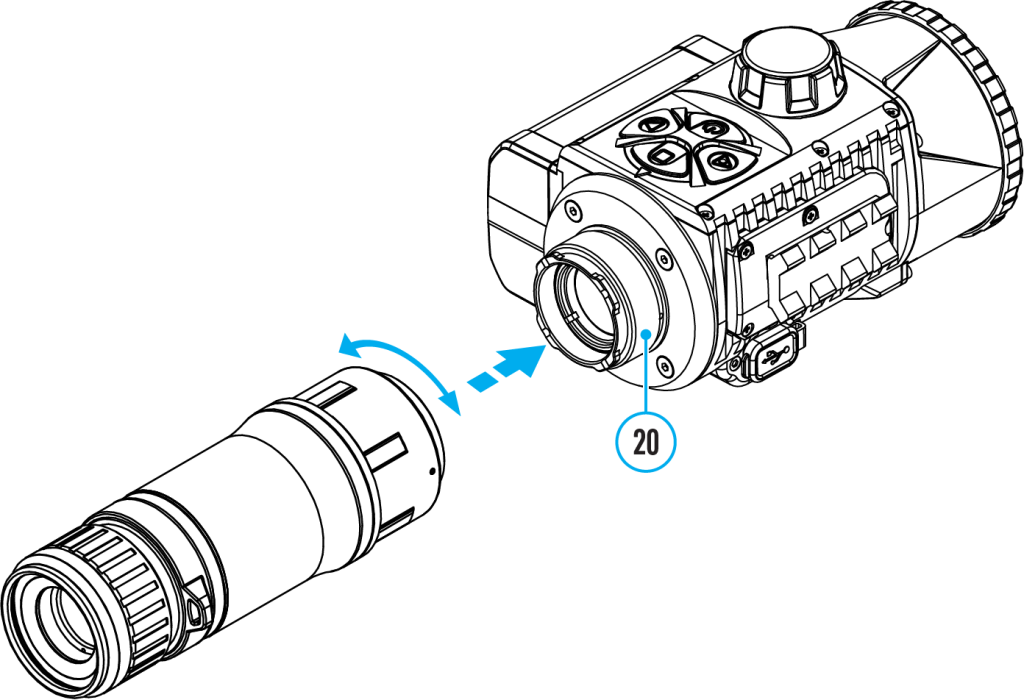
The Pulsar 5×30 B monocular (available separately) allows you to transform the attachment into a hand-held thermal imager with 5x magnification.
- Align the tabs on the monocular with the slots of the mount (20).
- Turn the monocular clockwise to secure it on the thermal imaging attachment.
- To remove the monocular, turn it counterclockwise and disconnect from the attachment.
Notes:
- The monocular can be installed on a thermal imaging attachment with an adapter already installed. The Ring Adaptor must be mounted onto the mounting area (20) of the attachment until it stops.
- The monocular can be installed on the device with an adapter installed only if the original PSP adapter is installed. This may not be possible when using an adapter from other manufacturers.
- The single-point neck strap (available separately) can be used with the monocular.
Mounting attachment on optical riflescope
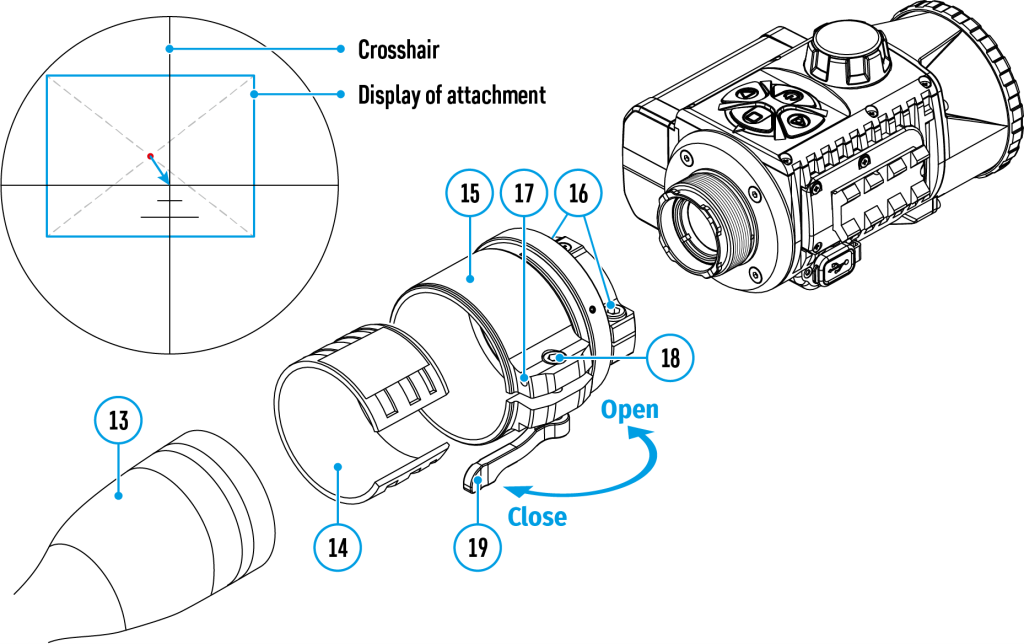
1. Remove the eyepiece cover (2).
2. Select the Ring Adapter (15) (sold separately) with the insert (14) of the required diameter depending on the outer diameter of the lens of your riflescope (13). The designation 42 mm / 50 mm / 56 mm in the name of the adapter means the lens diameter of the riflescope.
3. Screw together the Ring Adapter (15) and the attachment along the threads of the mounting area (20) until it stops. Then untighten a little (no more than one turn) so that the lever (19) is on the right side (see Figure).
4. Evenly tighten the screws (16) until the ball joint grips in the Ring Adapter (15).
5. Apply 2-3 strips of double-sided tape to the outer surface of the insert of your choice (14).
6. Push the insert (14) of your choice into the Ring Adapter (15) until it stops.
7. Move the lever (19) to the OPEN position.
8. Before installing the Ring Adapter (15) onto the riflescope, it is recommended to degrease the lens body of the riflescope (13).
9. Mount the Ring Adapter (15) with the insert (14) onto the lens of the riflescope (13) as far as it will go.
10. If the Ring Adaptor (15) with the insert (14) selected according to the table cannot be mounted onto the lens (10), follow the steps below:
- Loosen the locking screw (17) with a 2mm Allen key.
- Untighten the screw (18) with a hex wrench (S = 4mm) until the Ring Adaptor with the insert can be mounted onto the lens (13).
11. Move the lever (19) from its initial OPEN position to the CLOSE position.
12. Loosen the locking screw (17) with a 2mm Allen key, if it hasn’t been done before.
13. Tighten the screw (18) using a 4mm Allen key. The clamping force should be 1.5-2 Nm (use a torque screwdriver) to ensure the lever is correctly tightened (19), while the Ring Adapter with the attachment should not move relative to the body of the riflescope (13). If necessary, tighten or loosen the screw (18) to operate the lever (19) in the best way possible.
14. Tighten the locking screw (17) as far as it will go.
15. Turn on the attachment by briefly pressing the ON/OFF (9) button.
16. Align the display center with the crosshairs of the reticle by tilting the attachment.
17. Align top and bottom display boundaries parallel to the horizontal axis of the riflescope by turning the attachment clockwise or counterclockwise.
18. Having reached the best possible position of the attachment, tighten two screws (16) until stop. The clamping force should be 6.5-7.5 N·m (use a torque screwdriver to check).
Selection table for riflescope inserts
| Ring Adapter model | The internal diameter of the insert needs to match the outer diameter of the objective lens housing of the daylight riflescope it is being installed on | |
| Insert internal diameter, mm | Suitable for lens housing of daylight riflescope with an outer diameter of, mm | |
| PSP Ring Adapter 42 mm | 45.5 | 45.5 |
| 46 | 46 | |
| 46.5 | 46.5 | |
| 47 | 46.7-47.6 | |
| 48 | 47.7- 48.6 | |
| 49 | 48.7-49.6 | |
| 50 | 49.7-50.6 | |
| PSP Ring Adapter 50 mm | 51.6 | 51.6 |
| 53.4 | 53.4 | |
| 55 | 54.7-55.6 | |
| 56 | 55.7-56.6 | |
| 57 | 56.7-57.6 | |
| 58 | 57.7-58.6 | |
| 59 | 58.7-59.6 | |
| PSP Ring Adapter 56 mm | 60 | 59.7-60.6 |
| 61 | 60.7-61.6 | |
| 62 | 61.7-62.6 | |
| 63 | 62.7-63.6 | |
| 64 | 63.7-64.6 | |
| 65 | 64.7-65.6 | |
Interface
Status bar

The status bar is at the bottom of the display and displays information on the actual operating status of the device, including:
- Color Mode (shown only when the Black Hot color mode is selected)
- Auto shutdown function (for example, 5 min)
- Microphone
- Calibration Mode (in Automatic calibration mode a countdown timer will appear instead of the calibration mode icon 3 seconds before automatic calibration begins).
- Power Indication:
![]() – charge level if the device is powered by a battery
– charge level if the device is powered by a battery
![]() – charge level if the device is charging and powered by a battery
– charge level if the device is charging and powered by a battery
![]() – no battery, the device is connected to an external power supply.
– no battery, the device is connected to an external power supply.
- Observation Mode
- Video recording status:
![]() – video recording is on
– video recording is on
![]() – pause
– pause
![]() – video recording is off
– video recording is off
- Wi-Fi Connection
- Time
- Bluetooth
Quick menu functions
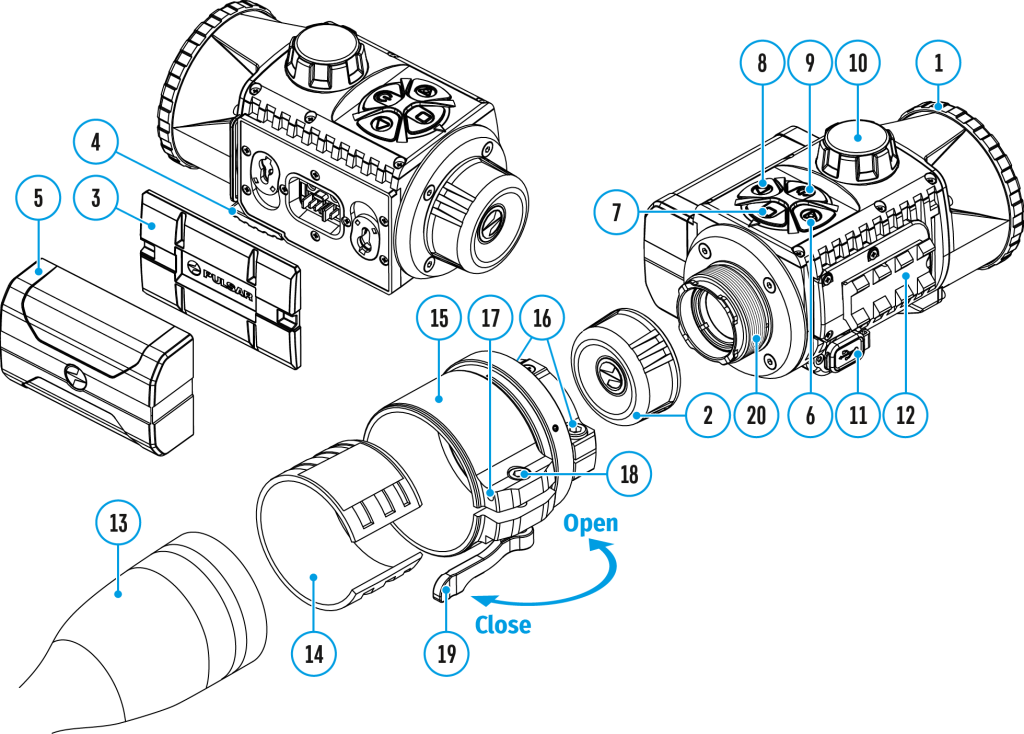
- Enter the menu with a short press of the MENU (7).
- To select the functions below, press successively MENU (7).
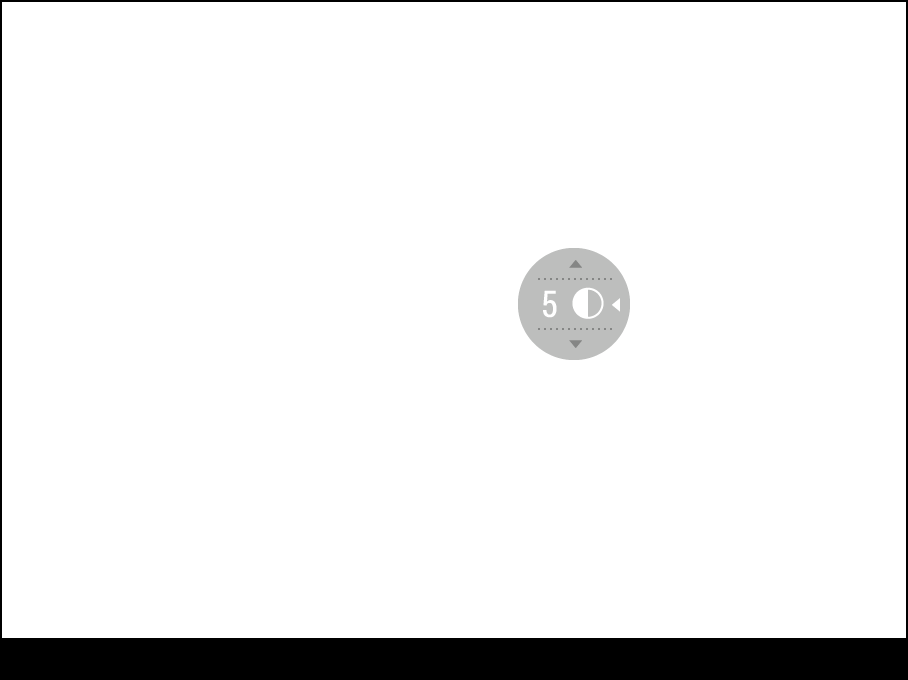
Contrast ![]() – press the RIGHT (6)/LEFT (8) buttons to change the display contrast value from 0 to 20.
– press the RIGHT (6)/LEFT (8) buttons to change the display contrast value from 0 to 20.
Brightness ![]() – press the RIGHT (6)/LEFT (8) buttons to change the display brightness value from 0 to 20.
– press the RIGHT (6)/LEFT (8) buttons to change the display brightness value from 0 to 20.
Basic mode ![]() – it allows you to select one of the three observation modes (Forest, Rocks, Identification) as the basic one for the user mode.
– it allows you to select one of the three observation modes (Forest, Rocks, Identification) as the basic one for the user mode.
- To exit the menu, press and hold down the MENU (7) button, or wait 10 seconds for automatic exit.
Main menu
Enter the main menu

- Enter the menu with a long press of the MENU (7) button.
- Press the RIGHT (6)/LEFT (8) buttons to move through the menu functions.
- One short press of the MENU (7) button opens a menu item.
- To exit the menu, press and hold down the MENU (7) button.
- Automatic exit from the menu occurs after 10 seconds of inactivity.
Note: When entering the main menu, the background image darkens to enhance the menu visibility. This is normal and not a defect.
General view of the menu:
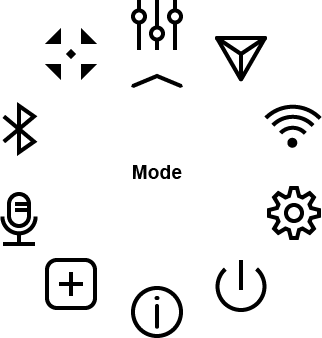
Mode
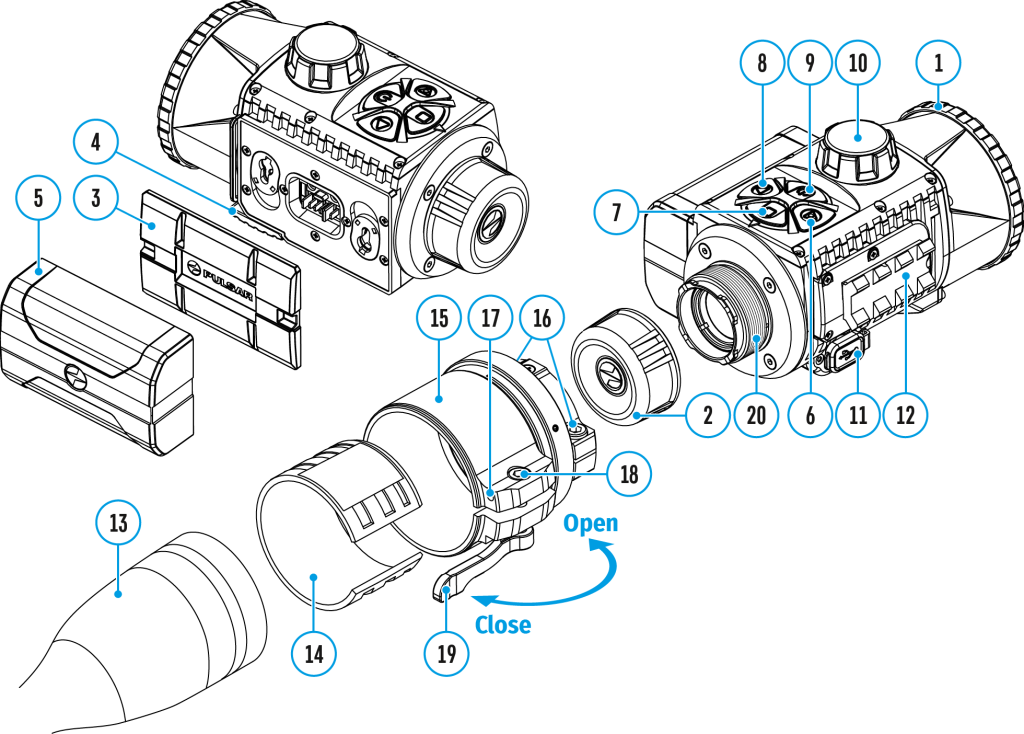
The device has four observation modes of the thermal imager: Forest (observation mode of objects within low thermal contrast conditions), Rocks (observation mode of objects within high thermal contrast conditions), Identification (high detalization mode), and User (individual brightness and contrast settings).
Option 1:
Briefly press the MODE (8) button to switch observation modes.
Option 2:
- Press and hold the MENU (7) button to enter the menu.
- Select the Mode
 option with RIGHT (6)/LEFT (8) buttons.
option with RIGHT (6)/LEFT (8) buttons. - A short press of the MENU (7) button opens the menu.
- Select one of the modes described below with RIGHT (6)/LEFT (8) buttons.
- A short press of the MENU (7) button confirms the selection.
![]() Forest This is the best mode when searching and observing within field conditions, against the background of leaves, bushes and grass. The mode is highly informative about an object being observed as well as landscape details.
Forest This is the best mode when searching and observing within field conditions, against the background of leaves, bushes and grass. The mode is highly informative about an object being observed as well as landscape details.
![]() Rocks. This is the best mode when observing objects after a sunny day or within urban conditions.
Rocks. This is the best mode when observing objects after a sunny day or within urban conditions.
![]() Identification. This is the best mode when observing objects within adverse weather conditions (fog, mist, rain and snow). It allows you to recognize the characteristics of an object being observed more clearly. Increased detail may be accompanied by insignificant image graininess.
Identification. This is the best mode when observing objects within adverse weather conditions (fog, mist, rain and snow). It allows you to recognize the characteristics of an object being observed more clearly. Increased detail may be accompanied by insignificant image graininess.
![]() User. It allows you to configure and save custom brightness and contrast settings, as well as one of the three modes (Forest, Rocks, Identification) as a base.
User. It allows you to configure and save custom brightness and contrast settings, as well as one of the three modes (Forest, Rocks, Identification) as a base.
Image detail boost
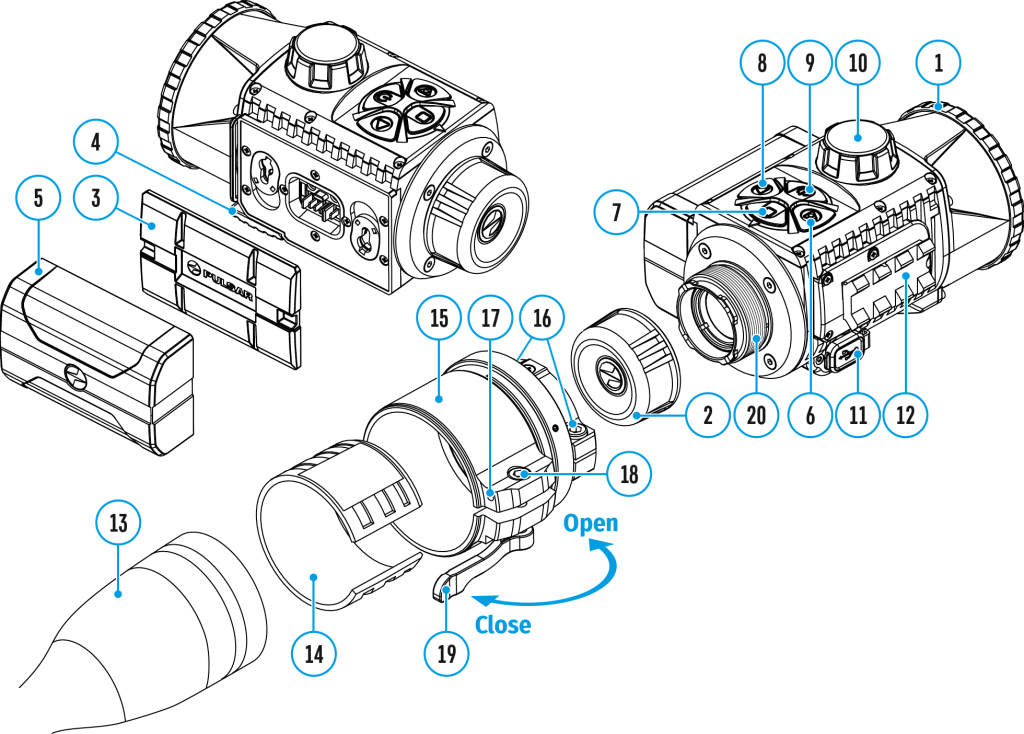
The Image Detail Boost ![]() function increases the sharpness of the contours of heated objects, which increases their detail. The result of the function depends on the selected mode and observation conditions: the higher the contrast of objects, the more noticeable the effect. This option is enabled by default, but can be disabled in the main menu.
function increases the sharpness of the contours of heated objects, which increases their detail. The result of the function depends on the selected mode and observation conditions: the higher the contrast of objects, the more noticeable the effect. This option is enabled by default, but can be disabled in the main menu.
Turn on/off Image Detail Boost
- Press and hold the MENU (7) button to enter the menu.
- Select the Image Detail Boost
 option with the RIGHT (6)/LEFT (8) buttons.
option with the RIGHT (6)/LEFT (8) buttons. - A short press of the MENU (7) button opens the submenu.
- To turn Image Detail Boost on or off press the RIGHT (6)/LEFT (8) buttons.
- Confirm your selection with a short press of the MENU (7) button.
Wi-fi settings

This menu option allows you to set up your device for operation in a Wi-Fi network.
- Press and hold the MENU (7) button to enter the menu.
- Select the Wi-Fi Settings
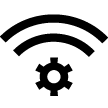 option with the RIGHT (6)/LEFT (8) buttons.
option with the RIGHT (6)/LEFT (8) buttons. - A short press of the MENU (7) button opens the menu section.
Wi-Fi Activation
Turn Wi-Fi on/off.
- Select the Wi-Fi Activation
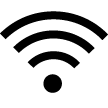 option with the RIGHT (6)/LEFT (8) buttons.
option with the RIGHT (6)/LEFT (8) buttons. - A short press of the MENU (7) button opens the submenu.
- To turn the Wi-Fi on or off press the RIGHT (6)/LEFT (8) buttons.
- Confirm your selection with a short press of the MENU (7) button.
Password Setup
This submenu allows you to set a password to access your thermal imaging attachment from a mobile device.
- Select the Password Setup
 option with the RIGHT (6)/LEFT (8) buttons.
option with the RIGHT (6)/LEFT (8) buttons. - A short press of the MENU (7) button opens the submenu.
- The default password (12345678) will appear on the screen.
- Set your desired password with the RIGHT (6)/LEFT (8) buttons. Press the MENU (7) button to toggle the digits.
- Press and hold down the MENU (7) button to save the password and exit the submenu.
Access Level Setup
This submenu allows you to set access levels of Stream Vision application to your device.
- Access level Owner. Stream Vision user has complete access to all device’s functions.
- Access level Guest. Stream Vision user has access only to real time video stream from the device.
- Select the Access Level Setup
 submenu with the RIGHT (6)/LEFT (8) buttons.
submenu with the RIGHT (6)/LEFT (8) buttons. - A short press of the MENU (7) button opens the submenu
- Select Owner or Guest with the RIGHT (6)/LEFT (8) buttons.
- Confirm your selection with a short press of the MENU (7) button.
General settings
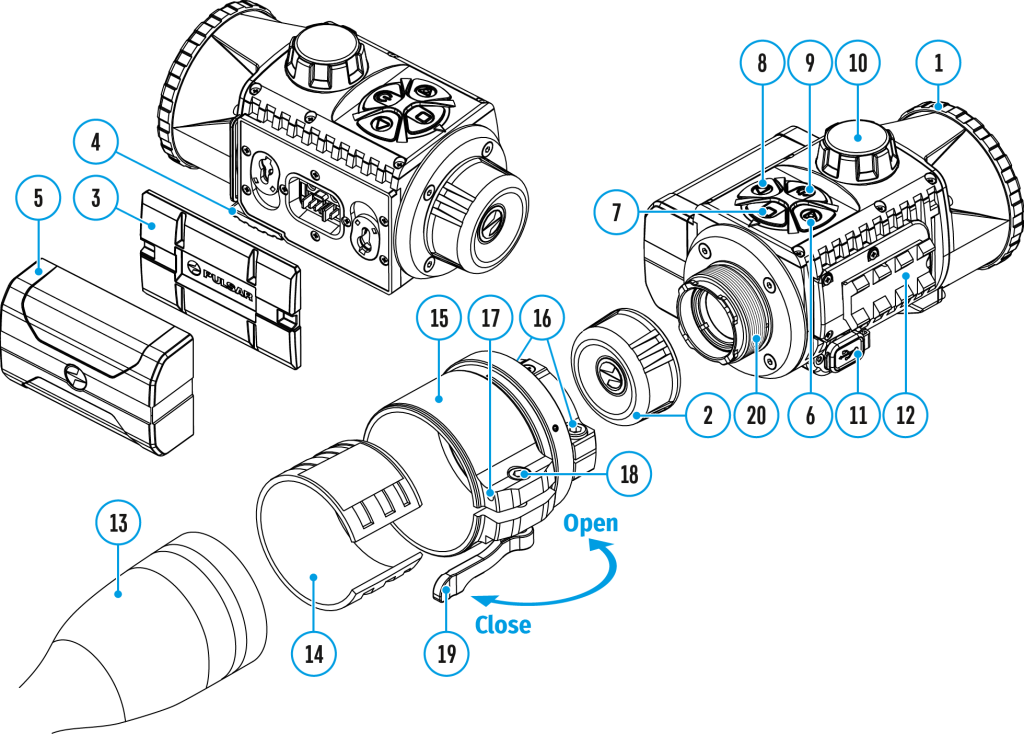
This menu section allows you to change the interface language, set the date, time, return the device to factory default settings and perform memory card formatting.
-
- Press and hold the MENU (7) button to enter the main menu.
- Select the submenu General Settings
 with the RIGHT (6)/LEFT (8) buttons.
with the RIGHT (6)/LEFT (8) buttons. - A short press of the MENU (7) button opens the submenu.
- Select the desired menu item with the RIGHT (6)/LEFT (8) buttons.
Icon Brightness
Adjust brightness level of the icons and screensavers (Pulsar, Display off) on the display.
- A short press of the MENU (7) button opens the Icon Brightness
 submenu.
submenu. - Use the RIGHT (6)/LEFT (8) buttons to select the desired brightness level from 0 to 10.
- Press the MENU (7) button briefly to confirm the selection.
Language
- A short press of the MENU (7) button opens the Language
 submenu.
submenu. - Select one of the available interface languages (English, French, German, Spanish or Russian) with the RIGHT (6)/LEFT (8)buttons.
- Confirm your selection with a short press of the MENU (7) button.
Date
- A short press of the MENU (7) button opens the submenu Date
 .
. - The date appears in dd/mm/yyyy format (01/01/2021).
- Set the required year, month and day with the RIGHT (6)/LEFT (8) buttons (the RIGHT (6) button increases the value and the LEFT (8) button reduces it). Press the MENU (7) button to toggle the digits.
- To save your chosen date and exit the submenu, press and hold the MENU (7) button.
Time
- A short press of the MENU (7) button opens the submenu Time
 .
. - Select the time format (24-hour clock or AM/PM) by pressing the RIGHT (6)/LEFT (8) buttons.
- Press the MENU (7) button to move to the hour setting.
- Set the hour with the RIGHT (6)/LEFT (8) buttons. The RIGHT (6) button increases the value and the LEFT (8) button reduces it.
- Press the MENU (7) button to move to the minute setting.
- Set the minute by pressing the RIGHT (6)/LEFT (8) buttons.
- To save your chosen time and exit the submenu, press and hold the MENU (7) button.
Default Settings
- A short press of the MENU (7) button opens the submenu Default Settings
 .
. - Select the Yes option to reset to factory settings or No to cancel using the RIGHT (6)/LEFT (8) buttons.
- Confirm your selection with a short press of the MENU (7) button.
- If Yes is selected, display will show “Do you want to restore default settings?” and Yes and No options. Select Yes to restore the default settings.
- Selecting the No option will cancel the reset and exit the submenu.
The following settings will be restored to their factory state before being set by the user:
- Video recorder mode – video
- Observation mode – Forest
- Calibration mode – automatic
- Language – English
- Wi-Fi – off (default password)
- Color palette – White Hot
Attention! When restoring the factory defaults the date, time and user pixel map are saved.
Format
Formatting the built-in memory card permanently deletes all of the recorded files.
Formatting should be carried out in case of a memory card error.
Attention! Make sure that you no longer need the files to be deleted or create a backup on other media.
- A short press of the MENU (7) button opens the submenu Format
 .
. - Select the Yes option to format or No to cancel using the RIGHT (6)/LEFT (8) buttons.
- Confirm your selection with a short press of the MENU (7) button.
- If Yes is selected, the message “Do you want to format the memory card?” appears on the display as well as Yes and NoSelect Yes to format the memory card.
- Selecting the No option will cancel the formatting and exit the submenu.
Auto shutdown
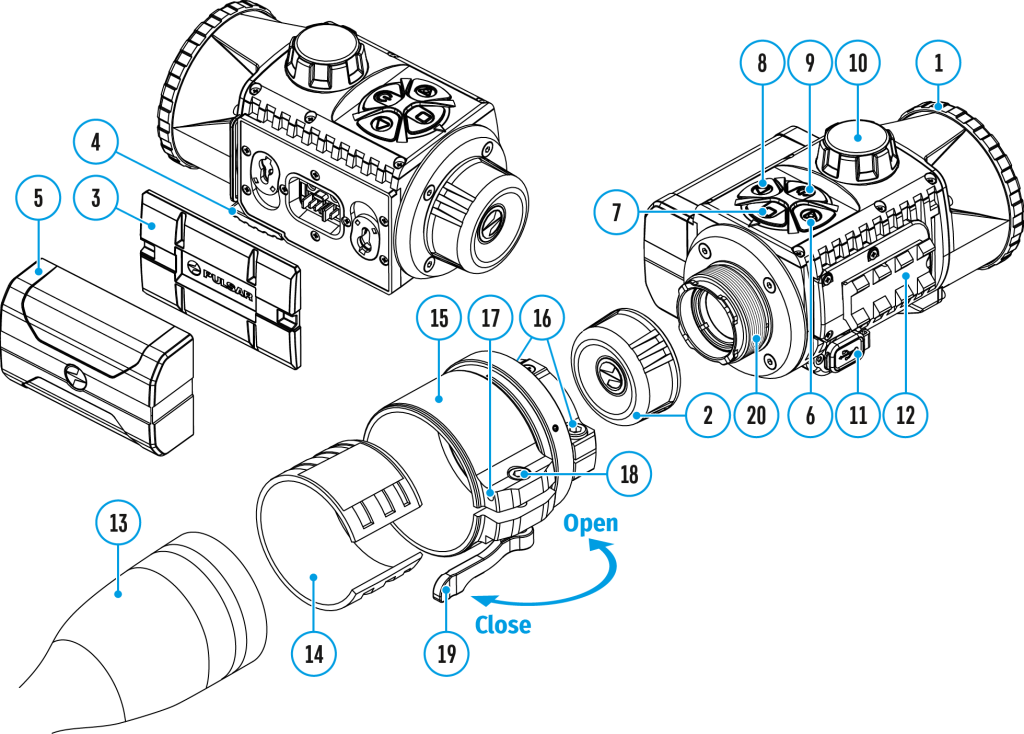
This item allows you to activate the auto shutdown function for when the device is in a non-operating position (tilted up or down at an angle of more than 70°, right or left at an angle of more than 30°).
- Press and hold the MENU (7) button to enter the main menu.
- Use the RIGHT (6)/LEFT (8) buttons to select the Auto Shutdown
 submenu.
submenu. - Press the MENU (7) button briefly to enter the submenu.
- Use the RIGHT (6)/LEFT (8) buttons to select the time period (1 min, 3 min, 5 min) upon expiry of which the device will automatically shut down, or select Off if you wish to deactivate Auto Shutdown.
- Press the MENU (7) button briefly to confirm the selection.
Note: If the Auto shutdown function is activated, the status bar shows an icon and shutdown time period as ![]() 1 min.
1 min.
Device information

This menu item allows the user to view the following information about the device:
- SKU Number
- Firmware Version
- Device Name
- Hardware Version
- Device Serial Number
- Service Information
To display information, do the following:
- Press and hold the MENU (7) button to enter the main menu.
- Use the RIGHT (6)/LEFT (8) buttons to select the Device Information
 icon.
icon. - Press the MENU (7) button briefly to view/exit the information.
Defective Pixel Repair
Defective pixel repair

When using the device, defective (dead) pixels may appear on the microbolometer. These are bright or dark points of a constant brightness that are visible on the image.
Krypton FXG50 thermal imaging attachments offer the possibility to repair any defective pixels on the microbolometer using firmware as well as to cancel removing.
![]()
- Press and hold the MENU (7) button to enter the main menu.
- Use the RIGHT (6)/LEFT (8) buttons to select the Defective Pixel Repair
 menu item.
menu item. - Press briefly the MENU (7) to open the submenu.
- Select the Defective Pixel Repair
 option by briefly pressing the MENU (7) button.
option by briefly pressing the MENU (7) button. - A marker (H)
 appears on the left side of the display.
appears on the left side of the display. - On the right side of the display appears a “magnifying glass” (G) – a magnified image in the frame with a fixed cross
 , designed for easier detection of a defective pixel and to match the pixel with the marker, and horizontal and vertical arrows for X and Y axes (I) showing the marker’s movement.
, designed for easier detection of a defective pixel and to match the pixel with the marker, and horizontal and vertical arrows for X and Y axes (I) showing the marker’s movement. - With a short press of the RIGHT (6)/LEFT (8) buttons move the marker to align it with a defective pixel.
- Switch the direction of the marker from horizontal to vertical and vice versa with a short press of the MENU (7) button.
- Align the defective pixel with the fixed cross in the frame – the pixel should disappear.
- Delete the defective pixel with a short press of the ON/OFF (9).
- Once the pixel has been successfully deleted an “OK” message will briefly appear on the screen.
- You can then delete another defective pixel by moving the marker across the display.
- Exit the Defective Pixel Repair submenu with a long press of the MENU (7).
Warning! The display of a thermal imager may have 1- 2 pixels represented as bright white or coloured (blue, red) dots which cannot be deleted and are not a defect.
Restore default pixel map

This option allows the user to return all previously disabled defective pixels to their original state.
- Press and hold the MENU (7) button to enter the main menu.
- Use the RIGHT (6)/LEFT (8) buttons to select the Defective Pixel Repair
 icon.
icon. - Press the MENU (7) button to enter the submenu.
- Use the RIGHT (6)/LEFT (8) buttons to select the Restore Default Pixel Map
 icon.
icon. - Activate the function by briefly pressing the MENU (7)
- Using the RIGHT (6)/LEFT (8) buttons, select Yes if you want to return to the factory pixel map and select No if you do not.
- Confirm your selection with a short press of the MENU (7)
Calibration mode
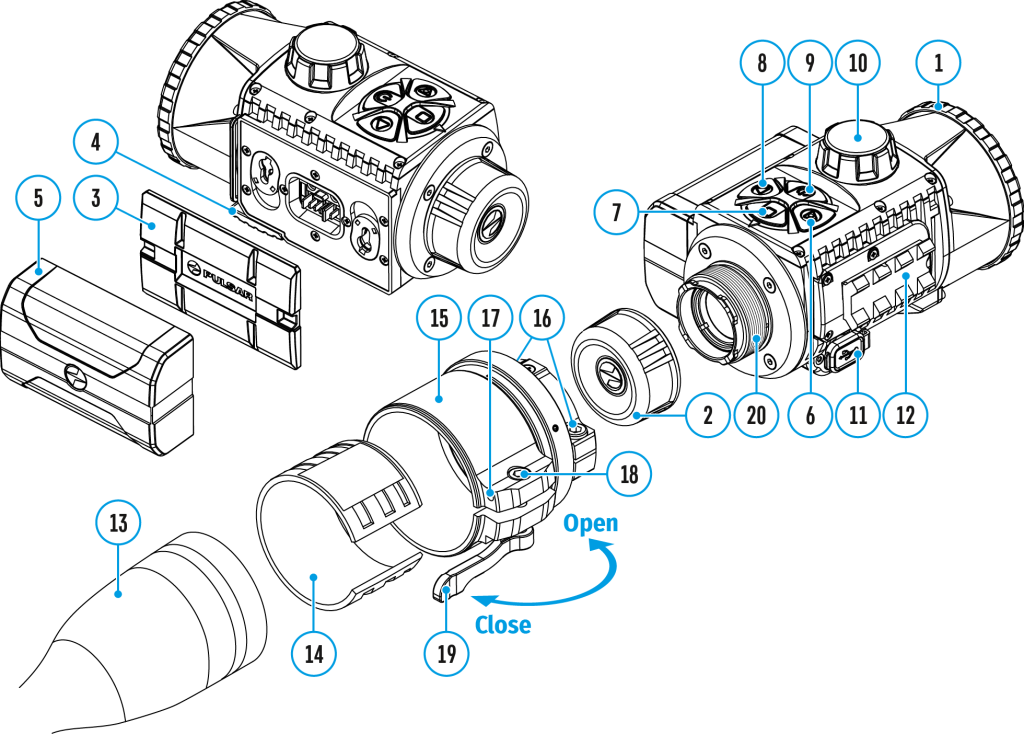
Calibration mode selection.
There are three calibration modes: Manual, Semi-Automatic and Automatic.
- Press and hold the MENU (7) button to enter the main menu.
- Use the RIGHT (6)/LEFT (8) buttons to select the Calibration Mode
 icon.
icon. - Press the MENU (7) button briefly to enter the submenu.
- Use the RIGHT (6)/LEFT (8) buttons to select one of the calibration modes described below.
- Press the MENU (7) button briefly to confirm the selection.
Automatic (A). In this mode the firmware determines the need for calibration. The calibration process starts automatically.
Semi-Automatic (SA). The user determines the need for calibration based on the image quality and can action at a convenient time depending on the object being observed.
Manual (M). In the Manual (silent) calibration mode the user determines the need for calibration (as in SA mode) but the lens cover must be closed during calibration.
Microphone

Turning microphone on/off.
This item allows you to enable (or disable) the microphone for recording sound during video recording.
- Press and hold the MENU (7) button to enter the main menu
- Select Microphone
 option with the RIGHT (6)/LEFT (8) buttons.
option with the RIGHT (6)/LEFT (8) buttons. - A short press of the MENU (7) button opens the submenu.
- To turn the microphone on or off press the RIGHT (6)/LEFT (8) buttons.
- Confirm your selection with a short press of the MENU (7) button.
Bluetooth

Turn on/off Bluetooth
- Press and hold the MENU (7) button to enter the main menu.
- Select the Bluetooth
 submenu with the RIGHT (6)/LEFT (8) buttons.
submenu with the RIGHT (6)/LEFT (8) buttons. - A short press of the MENU (7) button opens the submenu.
- Turn Bluetooth on/off with a short press of the MENU (7) button.
- Press and hold down the MENU (7) button to exit the submenu.
Functions
USB connection

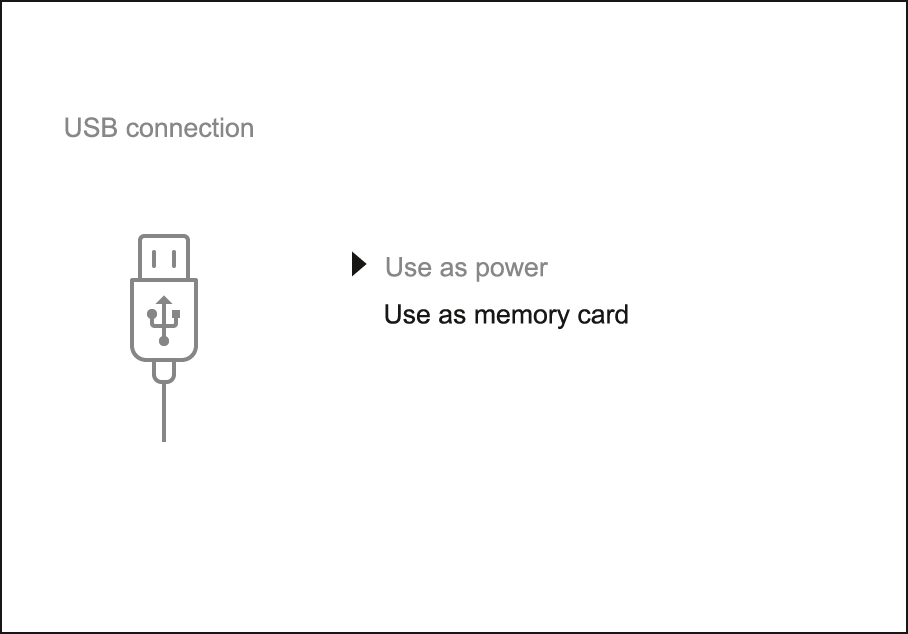
- Connect one end of the USB cable (22) to the device micro-USB port (11) and the other end to the port on your computer.
- Switch the device on with a short press of the ON/OFF (9) button (the computer will not detect the device if it is switched off).
- The device is detected by the computer automatically and no drivers need to be installed.
- Two connection modes will appear on the display: Use as power and Use as memory card.
- Use the RIGHT (6)/LEFT (8) buttons to select the connection mode.
- Press the MENU (7) button briefly to confirm the selection.
Use as power
- When this mode is selected, the computer is used as an external power supply. The icon
 appears in the status bar. The device will continue operating and all the functions are available.
appears in the status bar. The device will continue operating and all the functions are available. - A battery installed in the device will not be charged.
- When disconnecting the USB from the device connected in Use as power mode, the device will continue to operate from the rechargeable battery if it is present and provided it has enough charge.
Use as memory card
- When this mode is selected, the device is recognized by the computer as a flash card. This option is designed for working with files that are stored on the device’s built-in memory. However, the device functions are not available in this mode and it will switch off automatically.
- If video recording was in progress when the connection was made, recording stops and the video is saved.
- When USB cable is disconnected from the device in Use as memory card mode, the device remains turned OFF. Press the ON/OFF (9) button to turn on the device.
Video recording and photography

The Krypton FXG50 thermal imaging attachments are equipped with a video recording (photography) function where the observed image can be saved on the built-in memory card.
Before using this feature please set the date and time.
The built-in recorder operates in two modes:
Video Mode. Video Recording ![]()
- Switch to Video mode by pressing and holding the RIGHT/REC (6).
- The icon
 and the remaining recording time in HH:MM (Hours:Minutes) format are displayed in the upper left corner for a short time, for example, 5:12. In the status bar, the video recording status is displayed continuously.
and the remaining recording time in HH:MM (Hours:Minutes) format are displayed in the upper left corner for a short time, for example, 5:12. In the status bar, the video recording status is displayed continuously. - Press the RIGHT/REC (6) button briefly to start video recording.
- When the video recording starts, the icon will disappear and the REC icon and timer in MM:SS (Minutes:Seconds) format will appear.
- Press the RIGHT/REC (6) button briefly to pause or resume video recording.
- Press and hold the RIGHT/REC (6) button to stop video recording.
- Video files are saved to the built-in memory card after the video recording has been stopped.
- Press and hold the RIGHT/REC (6) button to switch between the video and photo modes.
Photo Mode. Capturing a photo ![]()
- Switch to Photo mode by pressing and holding the RIGHT/REC (6)
- Press the RIGHT/REC (6) button briefly to take a photo. The image freezes for 0.5 sec while the photo is saved to the internal memory.
Notes:
- You can enter and navigate the menu during video recording.
- The recorded videos and photos are saved to the built-in memory card of the device in the formats img_xxx.jpg (photos) and video_xxx. mp4 (video) where xxx is a 3 digit counter.
- The counter for multimedia files cannot be reset.
Attention!
- The maximum duration of a recorded video file is five minutes. After this time expires, the video is recorded to a new file.
- The number of recorded files is limited by the capacity of the internal memory of the device.
- Regularly check the free capacity of the internal memory and move recorded footage to other storage media to free up space on the internal memory card.
- In case of a memory card error, you can use the format function in the General Settings section of the main menu.
- When the Display Off function is activated, video recording is paused.
Wi-fi function
The device has a function enabling wireless communication with external devices (smartphone or tablet) via Wi-Fi.
- Turn on the wireless module in the WI-Fi Activation
 menu option.
menu option.
Wi-Fi is displayed in the status bar as follows:
| Connection Status | Indication on the status bar |
| Wi-Fi is switched off | |
| Wi-Fi connection is in progress |  |
| Wi-Fi is switched on, no connection with device | |
| Wi-Fi is switched on, device connected |
- The device is recognized by an external device as KRYPTON_XXXX where XXXX are the four last digits of the serial number.
- After entering the password on the external device (see the Password Setup subsection of the Wi-Fi Settings section for more information on setting a password) and setting up a connection, the icon
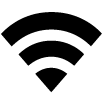 in the status bar changes to
in the status bar changes to  .
.
Display calibration

The attachment is configured so that after fitting onto an riflescope that had been properly zeroed, no adjustment of the aiming point is required. Yet if point of impact change is observed after putting on the attachment, you can fix it with display calibration procedure.
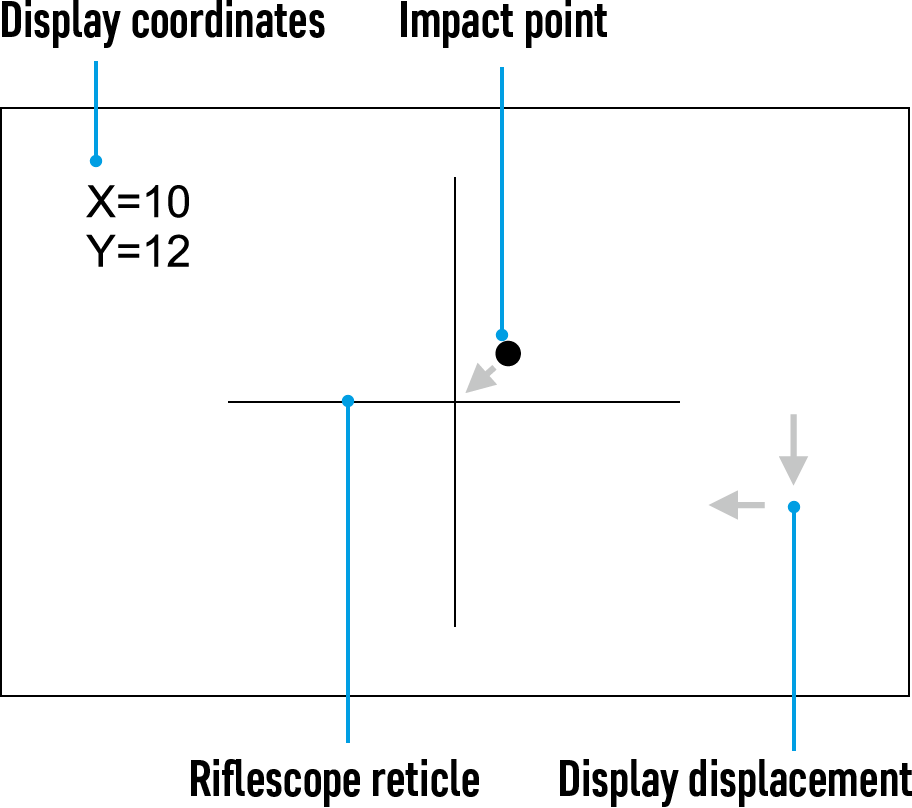
- To enter display calibration mode, first press and hold the MENU (7) button for 10 seconds.
- The display coordinates X=0; Y=0 will appear.
- Use the LEFT (8)/RIGHT (6) buttons to move the display horizontally (X axis) and vertically (Y axis) so that the point of impact moves to the centre of the riflescope reticle.
- Press the MENU (7) button to toggle between the X and Y coordinates.
- The image offset range is +/- 30 pixels horizontally (X axis), +/- 30 pixels vertically (Y axis).
- To exit the menu and save the settings, press and hold the MENU (7) button for two seconds.
Wireless Remote Control
Description of controls
The wireless remote control duplicates the functions of turning off the device, turning off the display, calibration, switching observation modes and palettes, video recording and photographing, and it allows navigation through the menu.
| Controller (25) | Button (26) | Button (27) | Button (28) | ||
| Short press | Enter the quick menu and submenus of the main menu / confirm the selection / Switch to the next item of the quick menu | Turn the display on / Calibrate the microbolometer | Switch observation modes | Start video recording / Capture a photo | |
| Long press | Enter/exit the main menu / Exit the quick menu | Turn the display off / Turn the device off | Turn on/off the Black Hot palette | Switch to photo/video mode | |
| Clockwise rotation | Quick menu | Increase parameter | 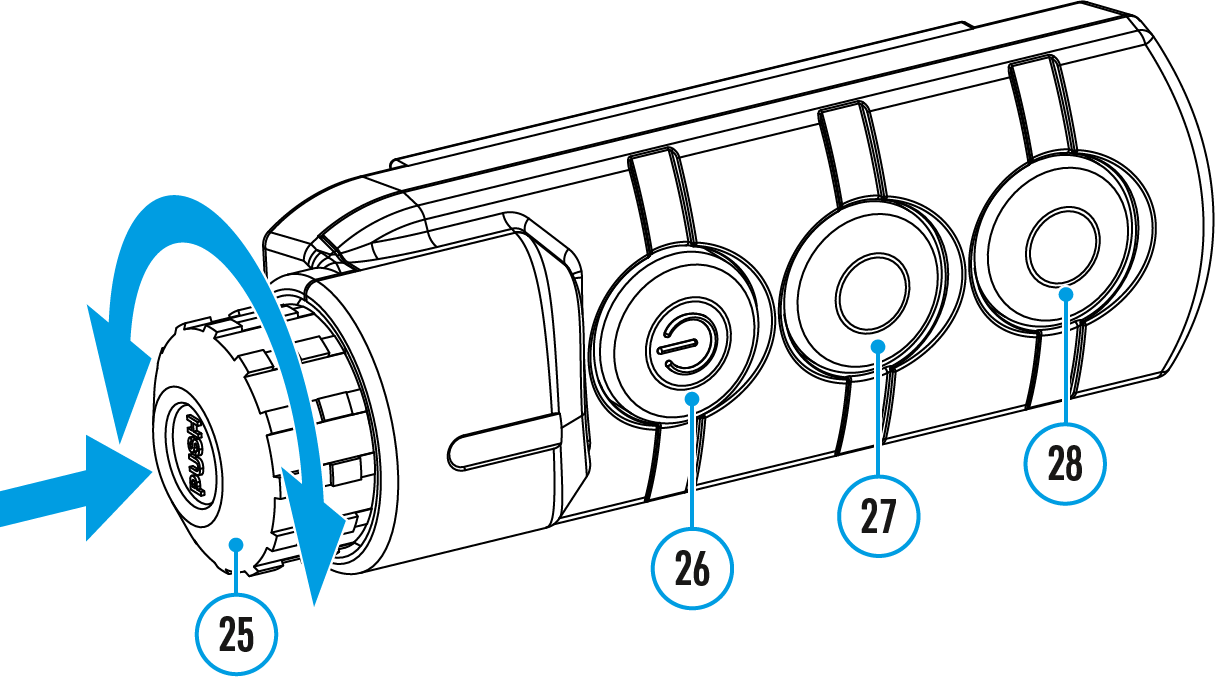 |
||
| Main menu | Navigate downwards/clockwise | ||||
| Counter-clockwise rotation | Quick menu | Decrease parameter | |||
| Main menu | Navigate upwards/counterclockwise | ||||
Remote control activation

- Turn on the Bluetooth module.
- In the Bluetooth
 section of the menu, use the RIGHT (6)/LEFT (8) buttons to select the Scan
section of the menu, use the RIGHT (6)/LEFT (8) buttons to select the Scan 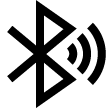 menu item.
menu item. - Confirm your selection with a short press of the МENU (7) button.
- Press and hold any button on the Remote Control. The Remote Control is visible in the Bluetooth network and can be connected during this time.
- Use the RIGHT (6)/LEFT (8) buttons to select the remote control from the dropdown list that appears.
- Confirm your selection with a short press of the МENU (7) button.
Notes:
- Once paired, the Remote Control can operate the Pulsar device.
- Going forward, the Remote Control will automatically connect to the paired device when within visible range.
- The name of the remote control and its battery charge level will appear in the list of paired devices at the bottom of the display in the Bluetooth
 section of the menu.
section of the menu.
Software
Firmware update
Stream Vision 2
- Download free Stream Vision 2 App in Google Play or App Store.
- Connect your Pulsar device to your mobile device (smartphone or tablet).
- Launch Stream Vision 2 and go to section “Settings”.
- Select your Pulsar device and press “Check firmware update”.
- Wait for the update to download and install. Pulsar device will reboot and will be ready to operate.
Important:
- if your Pulsar device is connected to phone, please turn on mobile data transfer (GPRS/3G/4G) to download update;
- if your Pulsar device is not connected to your phone but is already listed in “Settings” > “My devices” section, you may use Wi-Fi to download update.
Find answers to frequently asked questions about using Stream Vision 2 here.
Stream Vision
- Download free of charge Stream Vision App on Google Play or App Store.
- Connect your Pulsar device to your mobile device (smartphone or tablet).
- Launch Stream Vision and go to section “My Devices”.
- Select your Pulsar device and press “Check Updates”.
- Wait for the update to download and install. Pulsar device will reboot and will be ready to operate.
Important:
- if your Pulsar device is connected to phone, please turn on mobile data transfer (GPRS/3G/4G) to download update;
- if your Pulsar device is not connected to your phone but it’s already in the “My Devices” section, you may use Wi-Fi to download update.
Find answers to frequently asked questions about using Stream Vision here.
Is your firmware up to date?
Click here to check the latest firmware for your device.
Stream vision 2
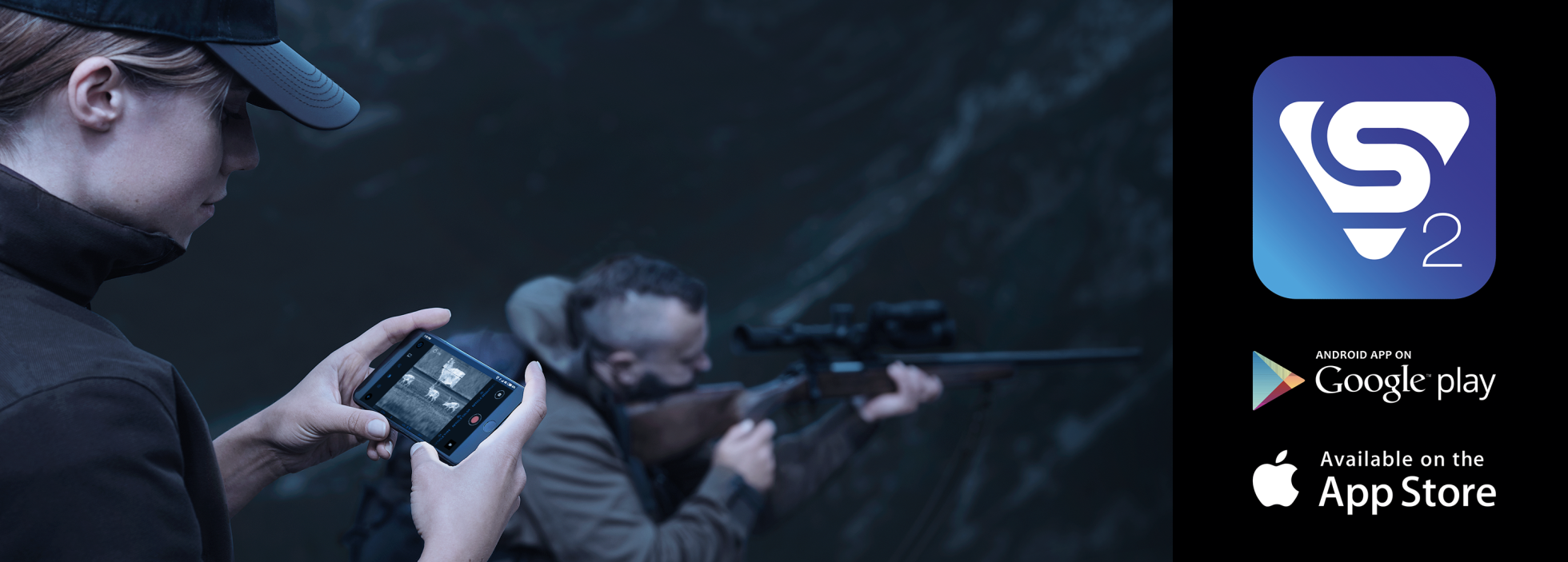
Krypton FXG50 thermal imaging attachments support Stream Vision and Stream Vision 2 mobile apps that allow you to stream real-time image from your device to your smartphone or tablet via Wi-Fi.
We recommend using the latest version – Stream Vision 2.

You can find further guidelines on Stream Vision 2 here.
Download from Google Play
Download from App Store
Find answers to frequently asked questions about using Stream Vision 2 here.

You can find further guidelines on Stream Vision here.
Download from Google Play
Download from App Store
Find answers to frequently asked questions about using Stream Vision here.
Maintenance
Technical inspection
It is recommended to carry out a technical inspection before each use of the device. Check the following:
- The device appearance (there should be no cracks on the body).
- The state of the objective and eyepiece lenses of the attachment (there should be no cracks, grease spots, dirt or other deposits).
- The state of the rechargeable battery (it should be charged) and the electric contacts (there should be no signs of salts or oxidation).
- The controls should be in working order.
- The attachment is properly and firmly fixed on the riflescope.
Technical maintenance and storage
Maintenance should be carried out at least twice a year and include the following steps:
- Wipe the exterior metal and plastic surfaces with a cotton cloth to remove dust and dirt. To avoid damage to the paint coating, do not use chemically active substances, solvents, etc.
- Clean the electrical contacts of the rechargeable battery on the device using a non-greasy organic solvent.
- Check the eyepiece and the lens and if required remove dust and dirt from the optics (preferably using a non-contact method). Cleaning of the exterior surfaces of the optics should only be done with products specifically designed for this purpose.
- Always store the device in its carrying case in a dry, well-ventilated space. For prolonged storage, remove the batteries.
Troubleshooting
For technical support please contact support@pulsar-vision.com.
Answers to frequently asked questions about the devices can also be found in the FAQ section.
The supplied USB cable is broken
Solution
To replace the USB cable, contact your local distributor.
Self-repair of the cable is prohibited.
The ability to use a USB cable from other manufacturers with the device may be limited.
Remote control does not work
Possible cause
The Bluetooth module is not turned on.
Solution
Turn on the Bluetooth module according to the instructions.
Possible cause
The Remote control is not activated.
Solution
Activate the remote control according to instructions.
Possible cause
The Remote Control is out of range of the device.
Solution
Return to the device coverage area.
Possible cause
Remote control battery low.
Solution
Install a new CR2032 battery as follows: unscrew the screws on the rear cover of the Remote Control, remove the cover, install a new battery, and screw the cover with screws.
Residual horizontal lines and traces of horizontally placed objects during observation process.
Possible cause
Algorithms that are used for image processing might sometimes cause traces of horizontal lines to temporarily appear on the image. This should not be considered as a critical error.
Device malfunction
Solution
In case of any malfunctions during operation, try resetting the device by long pressing the ON/OFF button for 10 seconds.
The device does not operate from an external power source
Possible cause
The USB cable is damaged.
Solution
Replace the USB cable.
Possible cause
The external power supply is discharged.
Solution
Charge the external power supply (if necessary).
Blurred image with vertical stripes or an uneven background
Possible cause
Calibration is required.
Solution
Perform image calibration according to the Microbolometer Calibration section of the manual.
Poor quality image. There is noise or ghost images of previous scenes or objects
Possible cause
Manual calibration has been performed with the lens cover open.
Solution
Check the Calibration Mode, close the lens cover and calibrate the device.
Black screen after calibration
Solution
If the image does not clear after calibration, you need to recalibrate.
When the device is turned on, the calibration frequency is at first higher, then decreases (if the automatic calibration mode is enabled)
Possible cause
After turning on the device, it takes some time for the sensor temperature to stabilize. This is normal and is not a defect.
Image is too dark
Possible cause
Brightness or contrast level is too low.
Solution
Adjust the brightness or contrast in the Quick Menu.
Color bars appear on the display or the image disappears
Possible cause
The device was exposed to static charges during operation.
Solution
When the exposure to static charges is over, the device may either reboot automatically or require to be switched off and on again.
The device does not turn on
Possible cause
The battery is completely discharged.
Solution
Charge the battery.
The image of the object being observed is missing
Possible cause
You are looking through glass.
Solution
Remove the glass or change the viewing position to avoid it.
Poor image quality / Reduced detection distance
Possible cause
These problems may occur during observation in adverse weather conditions (snow, rain, fog, etc.).
Smartphone or tablet cannot be connected to the device
Possible cause
Device password has been changed.
Solution
Delete the network and connect again using the password saved in the device.
Possible cause
The device is in an area with too many Wi-Fi networks that may be causing signal interference.
Solution
To ensure a stable Wi-Fi connection, relocate the device to an area with fewer or no Wi-Fi networks.
Missing or interrupted broadcasting via Wi-Fi
Possible cause
The smartphone or tablet is beyond reliable Wi-Fi range. There are obstacles between the device and the signal receiver (e.g. concrete walls).
Solution
Move the devices in line-of-sight and within range of the Wi-Fi signal.
When the device is used in low temperature conditions the image quality is worse than in positive temperatures.
Possible cause
In positive temperature conditions, objects being observed (surroundings and background) heat up differently because of thermal conductivity, thereby generating a high temperature contrast. Consequently, the image quality produced by the thermal imager will be better.
In low-temperature conditions, objects being observed (background) will cool down to roughly the same temperature, which leads to a greatly reduced temperature contrast and a degraded image quality. This is normal for all thermal imaging devices.
Legal compliances and disclaimers
Attention! A license is required for Thermal Imaging Front Attachment Krypton FXG50 when exporting outside your country.
Electromagnetic compatibility. This product complies with the requirements of European standard EN 55032: 2015, Class A.
Caution! Operation of this equipment in a residential environment could cause radio interference.
Updates of the Product. The manufacturer reserves the right at any time, without mandatory prior notice to the Customer, to make changes to the package contents (subject to the applicable laws, if any), design and characteristics that do not impair the quality of the Product.
Repair. Repair of the product is available within 5 years after purchase of the product.
Limitation of Liability. Subject to mandatory applicable laws and regulations: manufacturer will not be liable for any claims, actions, suits, proceedings, costs, expenses, damages or liabilities (if any), arising out of the use of this product. Operation and use of the product are the sole responsibility of the Customer. Manufacturer’s sole undertaking is limited to providing the product(s) and related services in accordance with the terms and conditions of concluded transactions, including provisions established in warranty. The provision of products sold and services performed by Manufacturer to the Customer shall not be interpreted, construed, or regarded, either expressly or implied, as being for the benefit of or creating any obligation toward any third party (other than Distributor, Dealer, Buyer). Manufacturer’s liability hereunder for damages, regardless of the form or action, shall not exceed the fees or other charges paid to Manufacturer for the product(s) and/or service(s).
MANUFACTURER WILL NOT BE LIABLE FOR LOST REVENUES OR INDIRECT, SPECIAL, INCIDENTAL, CONSEQUENTIAL, EXEMPLARY, OR PUNITIVE DAMAGES, EVEN IF THE MANUFACTURER KNEW OR SHOULD HAVE KNOWN THAT SUCH DAMAGES WERE POSSIBLE AND EVEN IF DIRECT DAMAGES DO NOT SATISFY A REMEDY.
